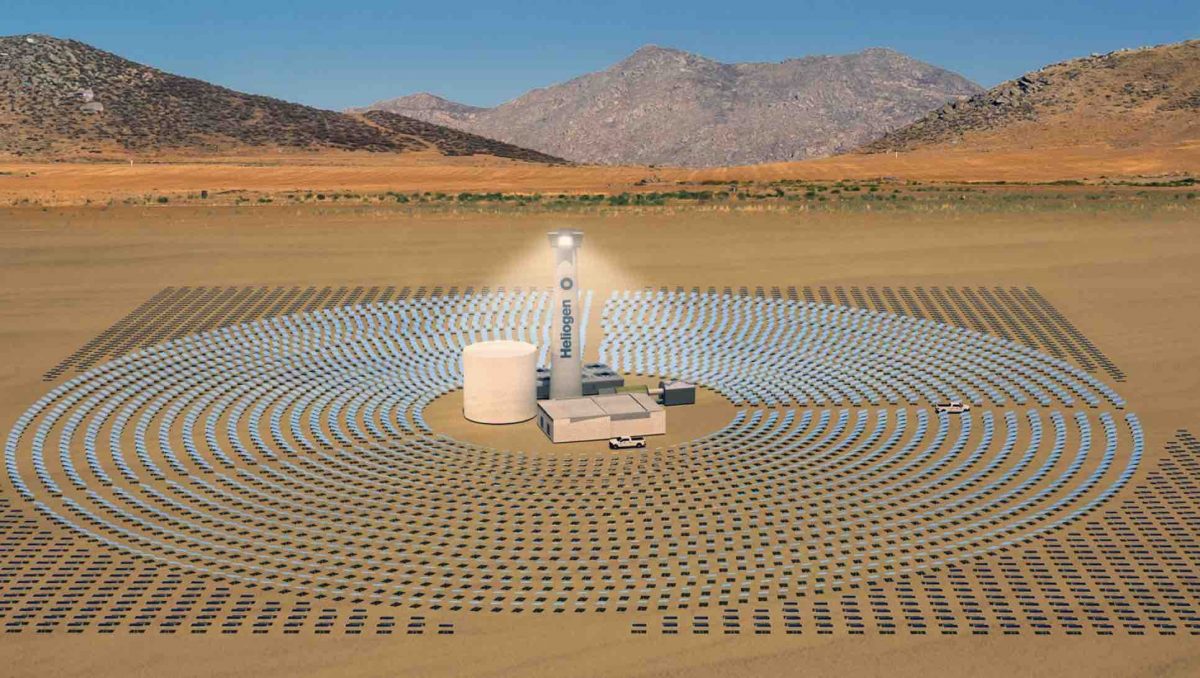Oil and gas giant Woodside Petroleum has agreed to help fund the construction of a 5MWe concentrated solar technology demonstration plant in California’s Mojave Desert, and has struck a deal that could see it use the technology for green hydrogen and other uses in Australia and around the world.
The deal – first flagged last year – has been struck with the California-based and Bill Gates-backed Heliogen, which was founded in 2013 with the goal of “replacing fossil fuels with the power of sunlight” and which has developed its own “AI-enabled” concentrated solar technology.
The Mojave Desert has been the location and the burial ground over the past decade of a series of concentrated solar technologies, which look to use large fields of mirrors to reflect sunlight to a target on the top of a tower where electricity or heat is produced or stored.
The technology has proved either too expensive or has had insurmountable technical challenges, including the SolarReserve technology that had grand plans for a massive $1 billion Aurora solar thermal project near Port Augusta before going bankrupt after problems at its flagship project in Nevada.
But the technology is now enjoying a mini renaissance, thanks to the success of projects in Chile, the work of RayGen in Australia (backed by AGL), and also companies like Heliogen and Australia’s Vast Solar.
Heliegon CEO and founder Bill Gross – who is also founder and chairman of gravity storage company Energy Vault – says his technology can store the solar energy (in tightly packed rock beds or salts), and deliver either “near” 24/7 power, heat for industrial uses, or incorporate a hydrogen electrolyser.
Gross describes this as a “sunlight refinery”, which might be a description that appeals to Woodside, given its oil and gas precedents.
The deal between the two companies will see Woodside Energy take an as yet unspecified equity stake in Heliogen and buy the components for a 5MWe concentrated solar plant in Mojave, which will also tap into funds made available from a $US39 million grant from the US Department of Energy.
The two companies have also signed an agreement to jointly market Heliogen’s technology in Australia for use by Woodside and other Australian customers.
This could include deploying “commercial-scale modules” of Heliogen’s heat and power offerings which may be combined with a hydrogen offering. The companies are also in similar discussions in relation to Heliogen’s technology in the U.S.
“Our agreements represent a pivotal next step in the commercialization of Heliogen’s breakthrough concentrated solar technology and the decarbonization of heavy industry,” Heliogen’s Gross said in a statement.
“The proposed Mojave facility will further advance our discussions with Woodside for additional opportunities aiming to produce carbon-free heat, power and hydrogen to help them achieve their sustainability goals.”
Heliogen has teamed up with the likes of Bloom Energy to develop electrolyser technology, and has previously announced a deal to install on of its modular units to provide power to Rio Tinto’s Boron mine in California.
Its board features highly respected energy executives including David Crane, the former head of progressive US utility NRG, and Paddy Padmanathan, the head of Saudi based energy giant Acwa, which has built massive solar thermal arrays in north Africa and the Middle East.
A recent investor presentation from Heliogen said that its technology could deliver power at US5c/kWh, and at a capacity factor of 85 per cent. It’s important to note that it is yet to actually build one of its 5MW modules, and the Woodside deal will be its first, unless the Rio Tinto one is completed beforehand.
Heliogen says the technical advances its made comes from the power of its “AI” tracking technology, breaking up the huge mirrors into 100 smaller mirrors that can be mass- manufactured and controlled by software, and through a smaller footprint. It also says it produces heat at higher temperatures of more than 1,000°C.
Woodside CEO Meg O’Neill said the company has set aside $US5 billion for investment in “new energy products and lower-carbon” services. She sees it as a “breakthrough” technology.
“Our collaboration with Heliogen on this innovative technology supports our commitment to building a low cost, lower-carbon, profitable, resilient and diversified portfolio,” O’Neill said.
Woodside has received a heap of criticism from environmental groups and some shareholders over its slow pace of decarbonisation. It has set a 2050 zero emissions goal but wants to invest in a series of massive fossil fuel projects in the meantime.
It has turned its attention to hydrogen, with large electrolyser plans for projects in Western Australia and Tasmania, potentially including up to 840MW of capacity. It has also committed to a 100MW solar project that could grow to 500MW, including battery storage of up to 400MWh.
Note: Neither Woodside nor Heliogen would provide more information on the scale and value of the equity stake in Heliogen. RenewEconomy also sought an update on the previously announced installation at the Rio Tinto mine without getting a response from either party before publication.










